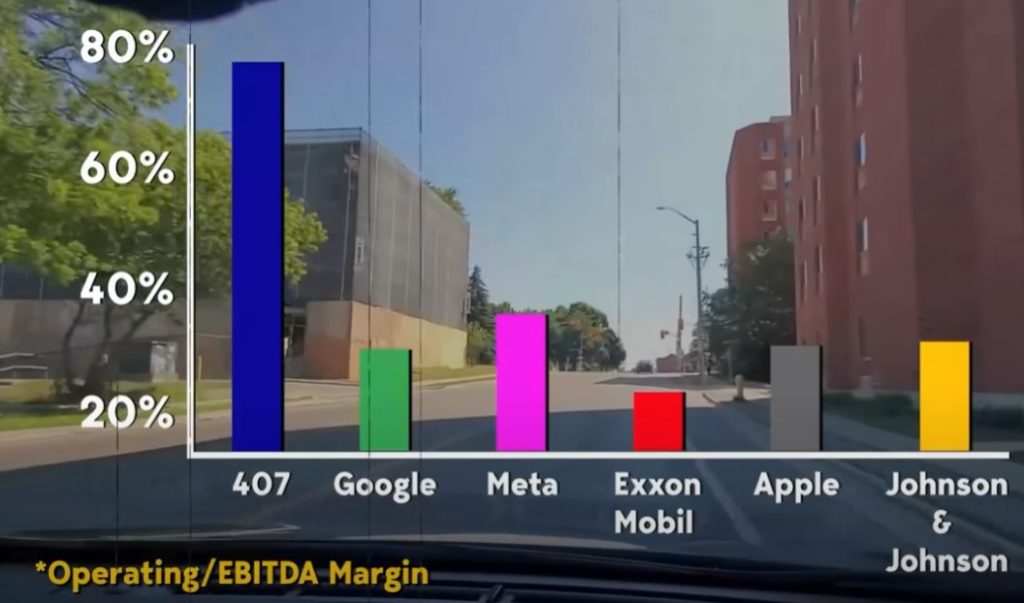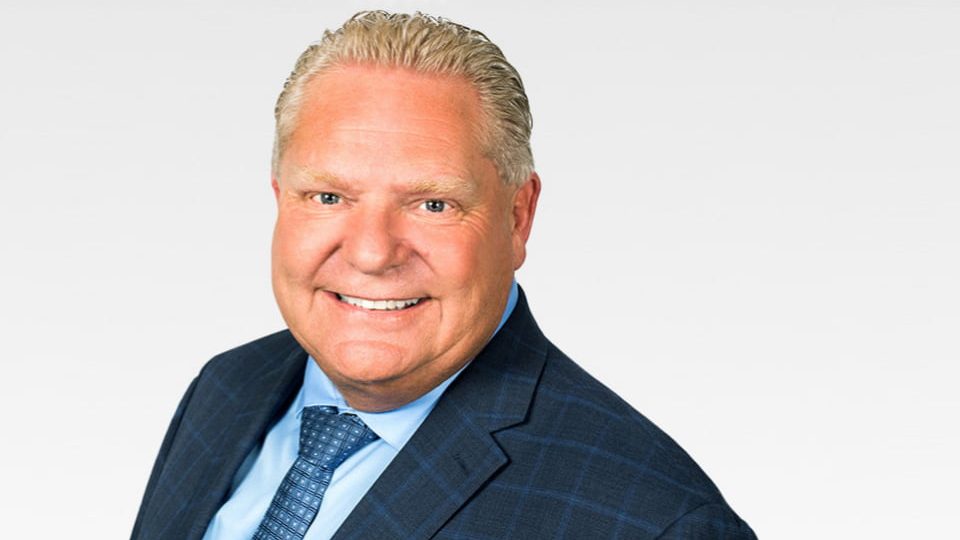Ontario taxpayers paid $1.6B for the construction of Highway 407, which was built to bypass the Toronto section of Highway 401.
Tolls would be charged for the first 30 years until the cost to build the highway was paid off and then it would become a free public highway like the 401.
However, in 1999, 2 years after it first opened, the highway was privatized by the Harris government – sold to private investors on a 99 year lease in order to balance their budget and win an election.
The government did not cap the rates the company could charge, as long as certain traffic levels are achieved (an arbitrator later ruled that 407 ETR has the power to raise toll rates without first consulting the government) and had passed legislation a year before the sale blocking license renewals of drivers with outstanding tolls, now on behalf of the company.
2 years later, the value of the highway was already double what government got for it by the private sector and in 2015, independent financial analysis argued the original lease was worth more than $12B at the time – $9B more than the province got for it.
Since then, Ontario taxpayers have been paying ever-increasing tolls that generate the company higher operating margins than US tech giants. Tolls that are high enough to make transport trucks choose to use the 401 instead, adding to its congestion.
Who owns 407 ETR?
407 International Inc. is currently owned by:
- Canadian Pension Plan Investment Board, the Crown corporation responsible for public employees retirement and Old Age Security (OAS) (50.01%)
- Cintra, a publicly-traded Spanish toll road and parking lot company (43.23%)
- AtkinsRéalis (SNC-Lavalin), Quebec-based engineering firm (6.76%)
It was most recently valued at $32B in 2019 when SNC-Lavalin sold part of its stake to Canadian Pension Plan investment Board (CPPIB).
How much does the 407 ETR make?
- 110.8M total trips
- 2.5B kilometers driven
- $13.23 average trip revenue
- $1.495B in revenue
- $567.3M net income
- $950M in dividend payments (separate financial statement)
Timeline
October 2, 2024 – Doug Ford says his buying back Hwy 407 is an option
When asked Wednesday at a news conference whether Ontario could instead buy back Highway 407 to get more cars off Highway 401 at a lower price, Ford did not rule it out:
All options are on the table — maybe both options
We’ll do the feasibility study. We’ll look at the 407 and see exactly which way are we going.
Premier Doug Ford
September 28-29, 2024 – Doug Ford says his government briefly considered buying back Hwy 407
Ford suggested that Highway 407 is now “worth approximately $35 billion” but said the government decided not to fork out to buy it back because of studies completed internally suggesting “all the 400 series highways are going to be at full capacity” in the next quarter-century.
We’ve thought of that as well
Previous government sold it off for $2.3 billion, which was the biggest mistake I’ve ever seen.
Studies have come out that we’ll be at full capacity in another 20, 25 years on the 407 — that defeats the purpose
Premier Doug Ford on interview with Ben Mulroney on AM 640 Radio
September 2023 – Environmental Defense says rates are pushing transport trucks to use 401 instead of the 407
At just over 100 kilometres along the route are three automobile assembly plants; three major railway yards; Pearson International Airport; the warehouses for Walmart, Amazon and Canadian Tire; the trucking industries of Brampton and Mississauga; the large construction and development industry in Woodbridge; and the massive food distribution warehouses in Ajax and Whitby.
In spite of all the traffic these activities create, there is an absence of trucks on the 407 ETR.
The commercial viability of the 407 ETR as an alternative to the 401 is dependent on the degree of toll reduction and the associated “willingness to pay” value of a reduction in journey time. As of May 2023 (and according to a representative from the PMTC), using the 407 ETR to avoid the City of Toronto costs an average of approximately $1.42 per km.
Google Maps data from peak times (i.e., around 5.30 pm) suggests that the journey from the point at which the 401 and 407 ETR meet in the West at Milton to Oshawa to the east of the City of Toronto on the 407 ETR has a total length of 97 km, uses roughly 88 km of tolled route, and can take as little as 50 minutes to travel. The toll for this journey would be approximately $125. In comparison, the same journey for the 401 is roughly 87 km, can take up 130 minutes, and is not tolled.
The difference between the length of these two routes is roughly 10 km. However, the potential difference in journey time could be as much as 80 minutes. Considering the average hourly wage of a trucker in Canada ($24 per hour), an additional 80 minutes of drive time only costs an additional $32. Comparing a $125 toll with a $32 additional wage contribution highlights the reason why shippers and
Comparison of Highway 413 and Highway 407 for Improving Truck and Freight Mobility in the Greater Toronto Area for Environmental Defense
receivers may be unwilling to pay to use the 407 ETR.
2022 – 407 generates $0.78 in profit per dollar charged, a higher operating/EBITDA margin than Google, Meta, Apple

April 21, 2021 – Ford’s government waives $1B “congestion payment” fine against 407 ETR for failing to meet traffic quota contractual obligations during the COVID-19 pandemic
According to internal government documents viewed by the Star, the 407 ETR’s owners (which include majority stakeholder Canada Pension Plan Investments) had the option of reducing tolls to encourage more drivers to use the highway, possibly preventing the congestion clause in the 407 ETR concession agreement from being triggered. But the 407 opted not to do so.
Toronto Star
May 21, 2019 – Doug Ford calls sale of Hwy 407 a mistake
What I don’t want to do and I would never do under our watch is start selling tollways off like the 407
What did they sell it for, $3 billion? And it’s worth what $20 billion now? So I don’t believe in selling off toll roads
Premier Doug Ford
March 2015 – Independent financial analysis argues the original lease was worth more than $12B, $9B more than the province received for it
2014 – Tolls had increased over 300% since the sale
November 7, 2005 – Ontario Divisional Court orders the Ontario Registrar of Motor Vehicles to deny vehicle permits to individuals who refuse to pay their 407 ETR tolls
2004 – 407 ETR sues to deny plate renewal for those who don’t pay
July 10, 2004 – Independent arbitrator confirms 407 ETR has the power to raise toll rates without first consulting the government
2002 – Harris says “The taxpayers of this province did very well with this sale” before retiring as premier
March 2002 – 3 years after the deal, SNC-Lavalin sold 26% of its stake to Grupo Ferrovial-Cintra for 4x what it paid, the value of Hwy 407 ($6.3B) was already double what was paid to the provincial government
May 5, 1999 – Harris’ PC government sells Hwy 407 for $3.1B (worth $4.4B in 2019) in 99 year lease for $1.5B profit on the eve of the provincial election, no limit placed on toll rates
The highway was sold to a group of investors:
- Grupo Ferrovial-Cintra, a publicly-traded Spanish toll road and parking lot company (61%)
- SNC-Lavalin (23%)
- Caisse de Depot et Placement du Quebec (16%)
At the time, 210,000 drivers used 407 daily, bringing in $9M in tolls.
PC government maximized short-term profits to fund election promises
The Liberals under Dalton McGuinty were ahead in the polls. Although those polls suggested most people believed the Tories were “on the right track” with their program of tax and spending cuts, education reform and tighter welfare rules, voters feared the government had mismanaged health care: firing nurses, angering doctors, ordering hospitals closed and letting services deteriorate. Tory strategists needed to reverse the impression that the government was starving the health sector of money. They were equally anxious to provide a further round of tax cuts as the centrepiece of their Blueprint election-campaign platform.
The solution was to sell off the brand new Highway 407.
The Globe and Mail
The difference between the bids for a 30-year lease and bids for a 99-year lease amounted to $100 million — not a large amount to cover a period of almost 70 years. Of course, making a commitment for an extra 70 years would tie the hands of future governments and future generations. But that apparently counted for little in the minds of Harris cabinet members, compared to the benefit of receiving an extra $100 million that could be put towards pre-election deficit reduction.
The Hamilton Spectator
No limit placed on rates
Harris’ government did not place a limit on how much the private company could charge drivers. Minister of Privatization Rob Sampson assured the public that tolls would not rise, because the new owners would need plenty of drivers to pay off the debt:
The limit is what the market is prepared to pay
And that is a realistic limit.
if people aren’t prepared to drive the highway because they feel the tolls aren’t fair, then these gentlemen aren’t going to honour their commitment to manage this highway.
Rob Sampson, Minister of Privatization
Within a year of the sale, toll rates rose by as much as 50 per cent, depending on the time of day. By the end of 2001, there had been four price hikes and increasing complaints about poor customer service.
TVO
Highway 407 Act allows the owner to block driver’s license renewals if tolls owed
Registrar’s action
If the Registrar of Motor Vehicles receives notice under subsection (1), he or she shall, at the next opportunity, refuse to validate the vehicle permit issued to the person who received the notice of failure to pay under section 16 and refuse to issue a vehicle permit to that person. 1998, c. 28, s. 22 (4).
Section 22 of the Highway 407 Act, 1998
Highway exempt from property taxes
Toll highways
8.1 Land that is a toll highway as defined in section 191.1 of the Highway Traffic Act that is leased from the Crown, including the roadbed, bridges or other structures supporting the roadbed or connecting the roadbed to other highways or roads, and any structure built over the toll highway and used as part of the system to determine the amount of the toll, fee or other charge to be made to users of the toll highway, including land that is intended to be used as a toll highway but that has not yet begun to be used for that purpose and that is not being used for any other purpose, but not including,
i. buildings, land used in connection with buildings, or parking lots, or
ii. land that is used for a purpose other than as a toll highway.
Section 3 (1) 8.1 of Assessment Act
Full Purchase Agreement (Source)
November 1998 – Harris government passes Bill 70 “An Act to engage the private sector in improving transportation infrastructure, reducing traffic congestion, creating jobs, and stimulating economic activity through the sale of Highway 407” to allow the sale
1998 – MPP E.J. Douglas Rollins claims province has invested $104B since the early 1970s acquiring the land for the highway
How many dollars do we have invested in the 407 at the present time? As of March 31, the taxpayers of Ontario have somewhere around $104 billion. If we have that $104 billion invested in capital and if we can take that back from the private sector, sell it and put those dollars back in, we’ll make one more promise in the Common Sense Revolution when we sell that asset.
Progressive Conservative MPP E.J. Douglas Rollins
1997 – Initial sections of the highway opened to the public
1995 – Progressive Conservatives “Common Sense Revolution” election platform advocated privatization of government assets such as LCBO and TVO
History has shown that the private sector can use such assets more efficiently and provide better service to the public
We believe the value of such assets is greater when being used to pay down the massive provincial debt than sitting on the government books.
1995 Ontario PC election platform
1987 – Rae’s NDP government funds the start of Highway 407, project breaks ground
1959-1986 – Hwy 407 proposed as part of the design of the 400 series of highways
Sources
- Wikipedia
- 407 ETR website (privately owned portion)
- Highway 407 website
- ‘The right to hold people to ransom’: How and why the Tories sold Highway 407 – TVO
- Cash grab prompted Tories’ sale of Hwy. 407 – The Globe and Mail (2000)
- Birth of a fiasco: How the Ontario Tories completely botched the sale of Highway 407 – The Hamilton Spectator (2019)
- The Highway 407 Fiasco: How a Big Business Deal Turned Sour – SmallCapSteve


Leave a comment
All comments are reviewed prior to appearing on the site.
Rules: